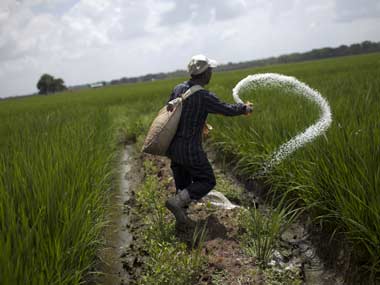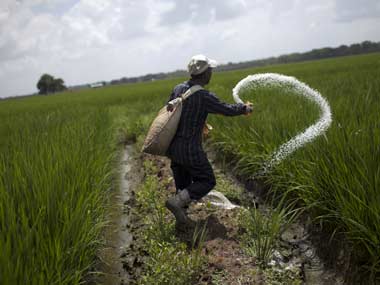What would you call a policy of subsidising foreigners to the tune of over Rs 35,000 crore annually? Asinine?
But that’s not the whole truth. The main point of the same policy is to subsidise Indian companies and importers, and the end-result is ruination of large tracts of farm land. And this, when the whole purpose of the policy is to enable India to feed itself.
Welcome to the government’s super-flawed fertiliser subsidy policy, for which the finance ministry had budgeted Rs 49,998 crore in the last budget. That figure has been missed by a mile. The subsidy has already been revised to around Rs 65,000 crore, and the ministry fears that ultimately it will end up shelling out Rs 90,000 crore in 2011-12 if nothing is done about it.
If the ultimate subsidy is closer to Rs 90,000 crore, foreign fertiliser companies will be subsidised to the tune of over Rs 35,000 crore. Reason: India imports 90 percent of its phosphatic fertilisers and 100 percent of potassic ones, according to The Economic Times.
The budget provides Rs 6,983 crore for urea import subsidies, Rs 13,308 for India-produced fertilisers, and Rs 29,706 crore for other “decontrolled” fertilisers, the bulk of which will be imported.
Having failed to discover any kind of spine to push through reforms on fertiliser subsidies, the government is now proposing a 40 percent hike in urea prices to remedy things, reports BusinessLine.
It probably won’t happen.
[caption id=“attachment_183677” align=“alignleft” width=“380” caption=“Having failed to discover any kind of spine to push through reforms on fertiliser subsidies, the government is now proposing a 40 percent hike in urea prices to remedy things.”]
 [/caption]
[/caption]
Impact Shorts
More ShortsLet’s be clear, the proposal for a 40 percent hike in fertiliser prices is DOA - dead on arrival. To expect politicians to push through urea price increases when elections are due in Punjab is like asking them to swallow cyanide. At best, one may see a marginal increase in prices, and the bulk of the reform will be pushed to next year. Even next year, don’t count on it coming through in its current pristine form.
Let’s see why the fertiliser subsidy scheme has become counter-productive. Worried about the rising subsidy bill, the finance ministry decreed two years ago that subsidies will be calculated differently. The subsidies would be fixed not on the basis of regulated end-prices (minus costs of production), but the subsidy itself would remain fixed based on the nutrient value of the fertiliser produced.
Thus, instead of having a fixed end-price and variable subsidies, it was decided that prices would float and subsidies capped based on nutrient value.
But the government goofed up by resorting to half-measures. While shifting to nutrient-based subsidies (NBS), it kept biggest fertiliser (urea) out of the scheme.
The net result: since urea prices were fixed, and the global prices of other fertilisers (potassium and phosphates) went up, the prices of the latter moved up significantly. As the gap between urea (which is nitrogenous) and potassic and phosphatic fertilisers widened, farmers shifted to urea, making fertiliser subsidies go even higher.
So, a scheme hatched to reduce fertiliser subsidies has ended up increasing it, because the government did not have the guts to go the whole hog.
An oft-used analogy illustrates why slow-motion reform does more damage than one-time shocks. If you put a frog in the water, and heat the water very, very slowly, the frog does not jump out as it does not feel the heat immediately. It gets used to the increasing warmth. It stays in the hot water till it is too late and dies.
This is the problem with reform in homoeopathic doses.
Continues on the next page
Fertiliser is exhibit A. As things stand now, the government has fixed the retail price of urea at Rs 5,310 a tonne, when imported urea costs Rs 20,819 and domestic urea Rs 13,076 per tonne.
Thanks to the sharply lower prices of urea, farmers use more of it in order to push up short-term productivity. The consequence, according to a report in India Today , is that farmers in Punjab - which, along with Haryana and western Uttar Pradesh, comprise India’s granary states - tend to use up to 49 times as much urea as agronomists prescribe.
Prolonged overuse of urea has resulted in contamination of the soil with chemicals and a decline in farm production. These chemicals have now seeped through to water tables, poisoning water sources. Overuse of urea can actually kill us.
One of the main objectives of shifting to nutrient-based subsidies was to eliminate the overuse of urea to the exclusion of potassic and phosphatic fertilisers. To obtain optimum results, farmers have to opt for the right balance of the three - and also use more organic fertilisers.
But we now have a situation where a subsidy meant to help farmers improve productivity actually ended up ruining their land and reducing productivity.
The remedies are obvious:
One, we need to move to market-based pricing of all fertilisers immediately. This will push up all fertiliser costs and force farmers to economise on their use.
Two, to mitigate the immediate impact on agricultural costs, farmers need to be compensated for it with higher food prices. In the short-term, fertiliser subsidies will thus be shifted to food subsidies. Over the long-term, as fertiliser use gets rationalised, farm productivity will impact food prices favourably.
Three, farmers cannot be left to their own devices when it comes to fertiliser use. To optimise fertiliser use without degrading land, India needs to improve farm extension services to manage this shift in fertiliser use without impacting food productivity.
Four, we need to realise that there can be no food security without farm security. To think that we can have food security by subsidising food for the poor while farmers are committing suicide ( over 17,000 in 2009 ) is unrealistic. We are essentially condemning one section of the poor to benefit another section.
Food security comes from making farming viable by improving agricultural productivity. But right now, both fertiliser and food subsidies are aligned to achieve the exact opposite.
)